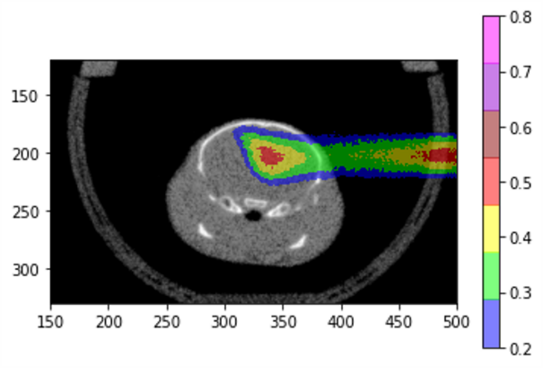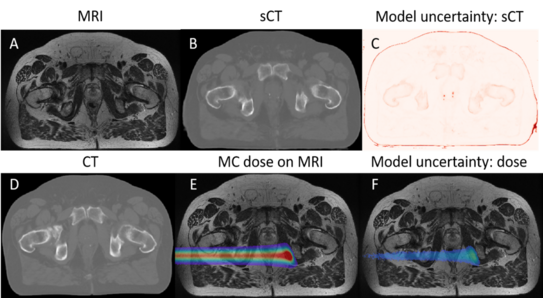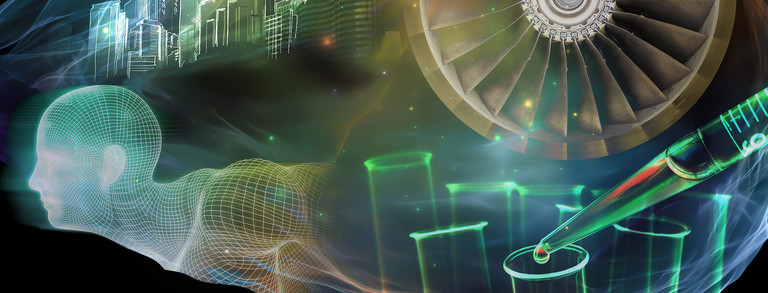Accurate dose measurement and prediction
One of our primary research focus is the accurate dose measurement and prediction, a critical area in ensuring the effectiveness and safety of proton therapy treatments. Within this focus, we are engaged in several cutting-edge subprojects. These initiatives aim to refine dose delivery and understand the biological effects of radiation, utilizing high-precision simulations and advanced imaging techniques. By developing methodologies that enhance treatment planning precision and adaptability, particularly through non-radiating imaging modalities like MRI, our work strives to contribute significantly to the field of medical physics and improve the quality of care for cancer patients.
Overview
One click will take you directly to the short description of the particular research project:
High-precision dose and LET simulations of mouse brain irradiation
High-precision dose and linear energy transfer simulations of mouse brain irradiation
Further investigation on biological effects of proton irradiation requires precise dose information in the respective area. As there is no general approach for including a computed tomography (CT) containing Hounsfield units in a Monte Carlo simulation framework, this project aims to use different CT calibration methods to provide an uncertainty estimation that results in a dose range per voxel.
The baseline CT calibration method is the widely used Schneider method (Schneider 2000). Another approach is the MATerial Assignment (MATA) approach (Permatasari et al., 2020) in combination with CT number to Stopping Power Ratio calibration curves. Dose simulation is performed with TOPAS (Perl et al., 2012).
Contact

- Sonia Shrestha. Establishment of a workflow for the simulation of dose and LET distribution for small animal irradiation with protons. Master thesis, 2023.
- Rabia Sen. Investigation of lateral beam profiles in small animal irradiation with protons. Bachelor thesis, 2023.
- Praveena Ravendran. Optimization of beam shaping of a setup for proton irradiation of mice using Monte Carlo simulation. Bachelor thesis, 2022.
- Jannine Salewski. Monte Carlo simulation for dosimetric validation for small animal irradiation with protons. Master thesis, 2021.
- Martin Lau. Efficiency optimization of a setup for the proton irradiation of mice using Monte Carlo simulations. Bachelor thesis, 2021.
- Suckert, T.; Müller, J.; Beyreuther, E.; Azadegan, B.; Brüggemann, A.; Bütof, R.; Dietrich, A.; Gotz, M.; Haase, R.; Schürer, M.; Tillner, F.; von Neubeck, C.; Krause, M.; Lühr, A. High-Precision Image-Guided Proton Irradiation of Mouse Brain Sub-Volumes. radiotherapy & oncology 2020, 146, 205-212. doi. org/10.1016/j.radonc.2020.02.023.
- Soltwedel, J.; Suckert, T.; Beyreuther, E.; Schneider, M.; Boucsein, M.; Bodenstein, E.; Nexhipi, S.; Stolz-Kieslich, L.; Krause, M.; Neubeck, C. von; Haase, R.; Lühr, A.; Dietrich, A. Slice2Volume: Fusion of Multimodal Medical Imaging and Light Microscopy Data of Irradiation-Injured Brain Tissue in 3D. Radiotherapy & oncology 2023, 182. doi. org/10.1016/j.radonc.2023.109591.
- Permatasari, F. F.; Eulitz, J.; Richter, C.; Wohlfahrt, P.; Lühr, A. Material Assignment for Proton Range Prediction in Monte Carlo Patient Simulations Using Stopping-Power Datasets. Physics in medicine and biology 2020, 65 (18), 185004. https://doi.org/10.1088/1361-6560/ab9702.
- Perl, J., et al. TOPAS: An innovative proton Monte Carlo platform for research and clinical applications. Medical Physics 2012, 39. https://doi.org/10.1118/1.4758060
Treatment planning for MRI-only proton therapy
State of the art proton therapy uses two image modalities: computed tomography (CT) and magnetic resonance imaging (MRI). While CT provides information of particle transfer in the patient, MRI shows anatomical information with high soft-tissue contrast with absence of unwanted ionizing radiation. The new concept of MRI-only proton therapy shows great potential and requires massive researches, one of which is the capability of MRI-only proton dose calculation.

One of the strategies is to, from MRI, generate a so-called synthetic CT (sCT) which allows dose calculation using conventional methods. Many tools have been proposed, among which DL-models are generally evaluated better. However, on the one hand, conventional proton dose calculation on sCT is still time and resource consuming. On the other hands, sCT generation models have uncertainties, which will leads to the uncertainty of dose calculation. It is of importance to be able to manage and even predict model uncertainties for not only sCT but also the final calculated proton dose.
Based on existing sCT generation methods, this project focuses on fast, accurate and trustworthy MRI-only proton dose calculation.
Contact
- Laura Tsu. Deep learning-based synthetic computed tomography generation from magnetic resonance imaging: investigating the effects of body contour mismatch. Bachelorarbeit, 2023
- L. Tian, A. Lühr, Proton range uncertainty caused by synthetic computed tomography generated with deep learning from pelvic magnetic resonance imaging, Acta Oncol. 62 (2023) 1461–1469. doi.org/10.1080/0284186X.2023.2256967




![[Translate to English:] Studierende, Gespräch, Fenster Students are talking in front of a large window](/storages/zentraler_bilderpool/_processed_/7/3/csm_Fensterfront-Gesprache-2_5ccc16e30c.jpg)

